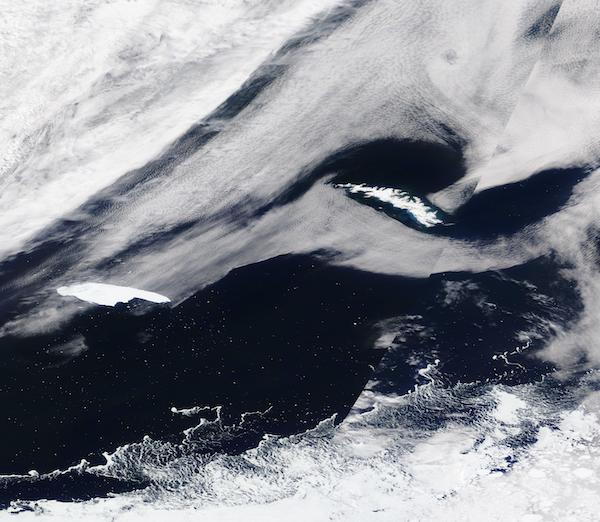Images
November 9, 2020 - A-68A Iceberg headed toward South Georgia Island
Tweet
A large Antarctic iceberg is drifting towards South Georgia Island, giving scientists and ecologists pause as they ponder potential impacts of a grounding of a massive ‘berg on the island’s population of seals, penguins, and birds.
The birth of iceberg A-68 occurred in July 2017, and NASA satellites captured early images of the massive iceberg shortly after it broke away from the Larsen C ice shelf. A-68 was one of the largest on record, spanning a surface area larger than the state of Delaware with estimated weight of about one trillion tons. After spending most of its first two years floating in the Weddell Sea close to the Larsen C ice shelf, by September 2018 the ‘berg began to float northward roughly parallel to the Antarctic Peninsula, all under the watchful eye of NASA satellites.
On November 5, 2020, the Moderate Resolution Imaging Spectroradiometer on the Terra satellite spotted iceberg A68-A approaching South Georgia Island.
Although the original A-68 lost two large chunks during the long northward journey, causing it to be renamed A-68A, the iceberg remains sizable. Estimated to measure about 98 mi (138 km) by 29 mi (48 km), A-68A is currently similar in size to South Georgia Island itself. South Georgia measures 104 miles (167.4 km) long and—at the widest point—23 miles (37 km) across.
South Georgia Island lies in the path of icebergs drifting northward from Antarctica, and several large ones have ended up carried by the strong currents of the Weddell-Scotia Confluence to ground on the broad continental shelf that surrounds the island. When the blocks of ice catch their keel on the continental shelf, they grind to a halt and slowly melt, dumping frigid, fresh water into the saline ocean. The dump of freshwater changes the structure of the water column, and this can change the currents across the continental shelf. The cooler, fresher water and the shifting currents can strongly impact the ecosystem, including the presence of krill, a tiny shrimp-like planktonic crustacean that is vital food for many marine organisms that feed the wide diversity of seabird colonies, seals, and penguins. As one of the bases of the marine food web, decreasing populations of krill could also impact the rich commercial fisheries found off of South Georgia Island.
Despite the already-close approach of A-68A to South Georgia Island and a real risk of grounding, the scenario is not yet set in stone (or ice). Icebergs very often make near-misses of the island and its broad continental shelf only to drift northward. Once in the warmer waters, even the largest ‘bergs then begin to melt.
Image Facts
Satellite:
Terra
Date Acquired: 11/5/2020
Resolutions:
1km (260 KB), 500m (824.4 KB), 250m (2.2 MB)
Bands Used: 1,4,3
Image Credit:
MODIS Land Rapid Response Team, NASA GSFC
Tweet
A large Antarctic iceberg is drifting towards South Georgia Island, giving scientists and ecologists pause as they ponder potential impacts of a grounding of a massive ‘berg on the island’s population of seals, penguins, and birds.
The birth of iceberg A-68 occurred in July 2017, and NASA satellites captured early images of the massive iceberg shortly after it broke away from the Larsen C ice shelf. A-68 was one of the largest on record, spanning a surface area larger than the state of Delaware with estimated weight of about one trillion tons. After spending most of its first two years floating in the Weddell Sea close to the Larsen C ice shelf, by September 2018 the ‘berg began to float northward roughly parallel to the Antarctic Peninsula, all under the watchful eye of NASA satellites.
On November 5, 2020, the Moderate Resolution Imaging Spectroradiometer on the Terra satellite spotted iceberg A68-A approaching South Georgia Island.
Although the original A-68 lost two large chunks during the long northward journey, causing it to be renamed A-68A, the iceberg remains sizable. Estimated to measure about 98 mi (138 km) by 29 mi (48 km), A-68A is currently similar in size to South Georgia Island itself. South Georgia measures 104 miles (167.4 km) long and—at the widest point—23 miles (37 km) across.
South Georgia Island lies in the path of icebergs drifting northward from Antarctica, and several large ones have ended up carried by the strong currents of the Weddell-Scotia Confluence to ground on the broad continental shelf that surrounds the island. When the blocks of ice catch their keel on the continental shelf, they grind to a halt and slowly melt, dumping frigid, fresh water into the saline ocean. The dump of freshwater changes the structure of the water column, and this can change the currents across the continental shelf. The cooler, fresher water and the shifting currents can strongly impact the ecosystem, including the presence of krill, a tiny shrimp-like planktonic crustacean that is vital food for many marine organisms that feed the wide diversity of seabird colonies, seals, and penguins. As one of the bases of the marine food web, decreasing populations of krill could also impact the rich commercial fisheries found off of South Georgia Island.
Despite the already-close approach of A-68A to South Georgia Island and a real risk of grounding, the scenario is not yet set in stone (or ice). Icebergs very often make near-misses of the island and its broad continental shelf only to drift northward. Once in the warmer waters, even the largest ‘bergs then begin to melt.
Image Facts
Satellite:
Terra
Date Acquired: 11/5/2020
Resolutions:
1km (260 KB), 500m (824.4 KB), 250m (2.2 MB)
Bands Used: 1,4,3
Image Credit:
MODIS Land Rapid Response Team, NASA GSFC




